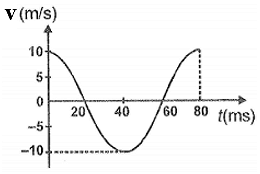For a simple harmonic oscillator, a velocity-time diagram is shown. The angular frequency of oscillation is:

1. rad/s
2. rad/s
3. 25 rad/s
4. 25 rad/s

In an S.H.M, when the displacement is one-fourth of the amplitude, the ratio of total energy to the potential energy is
1. 16: 1
2. 1: 16
3. 1: 8
4. 8: 1
A particle executing S.H.M. Its displacement x varies with time t as The maximum velocity of the particle will be:
1. 20 unit
2. 10 unit
3. 40 unit
4. 5 unit
The amplitude of oscillation for a particle executing S.H.M with angular frequency rad/s and maximum acceleration is
1. 25 cm
2. 25 m
3. 5 cm
4. 5 m
Which of the following statements is true for an ideal simple pendulum?
| 1. | The expression for the time period is true only for the oscillation of infinitely small amplitude. |
| 2. | The motion of the bob is rotatory. |
| 3. | The buoyancy of air has an appreciable effect on the motion of the bob. |
| 4. | All of these. |
A mass of \(30~\text{gm}\) is attached with two springs having spring constants \(100~\text{N/m}\) and \(200~\text{N/m}\) and other ends of springs are attached to rigid walls as shown in the given figure. The angular frequency of oscillation is:
(ground is smooth)

1. \(\dfrac{100}{2\pi}~\text{rad/s}\)
2. \(\dfrac{100}{\pi}~\text{rad/s}\)
3. \({100}~\text{rad/s}\)
4. \({200}~\text{rad/s}\)
If a bob of the simple pendulum having negative charge q is made to oscillate in a uniform electric field acting vertically upward direction, then its time period:
1. Increases
2. Decreases
3. No effect of the electric field
4. Decreases or increases
A simple pendulum of length l and bob of mass m is executing S.H.M with amplitude A. The maximum tension in the string will be
1.
2.
3.
4.
Find the percentage change in time period if the length of a simple pendulum is increased by 3%
1. 3%
2. 6%
3. 1.5%
4. 2.5%
A disc is oscillating about a horizontal axis passing through its rim and perpendicular to the plane of the disc. If the radius of the disc is R, then the frequency of oscillation is
1.
2.
3.
4.






